Go ahead and change the words below:
"Make the wrong thing hard and the right thing easy, every other
plan will fail under stress."
This presentation is interactive. So you can try out the code, or modify it. Have Fun!
If you want a better online editor go here. If you get stuck on something related to Clojure try the Clorian Slack #Beginners channel.
I was discussing programming languages on the Michigan Devs slack and someone said something very profound on the topic of discussing programming languages:
I believe the human tendency is to distill an important yet complex topic down to simple practical conclusions, and become emotionally attached to those conclusions. This is necessary in order to make confident high-level decisions on what to do about the topic within the contexts that we live, and defend those decisions later. As a result, perhaps the hardest thing to find in programming literature and communities are perspectives and ideas that are both reasonably objective and still useful within any single context. The diversity in programming environments and business contexts is so vast, that it is indeed very challenging to make any statement of wisdom that is broadly applicable. I think high-level discussions about programming languages and paradigms are very clear examples of this unfortunate dynamic.
I think Jerry has touched on something very important, that many of our decisions are made out of necessity. Many factors play into our choice of programming language:
Are just some of the considerations for what the "best language" is. So in reality, "best" is high subjective. So rather then argue about which language is best, i would rather talk about why I enjoy Clojure.

I enjoy Clojure because it helps me keep things simple.
There are a couple definitions but the one i like the most is:
Not Compounded
Compounded should summon images like this:
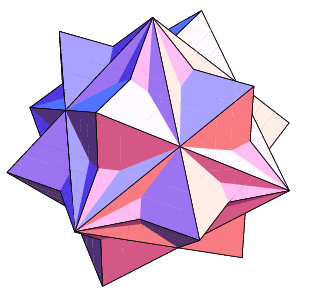
Of something entailed and intertwined, think "spaghetti code". You should have a slightly bad taste in your mouth.
It can scarcely be denied that the supreme goal of all theory is to make the irreducible basic elements as simple and as few as possible without having to surrender the adequate representation of a single datum of experience.
Which is often paraphrased as:
Everything should be made as simple as possible, but no simpler.
#Syntax
"Hello World"
This is a full program. It has complied just for your viewing pleasure. This is possible because
everything is Data. What we have below is a hash-map {}:
There are a small set of pieces from which we construct things in Clojure. These are displayed below in a map:
{
:string "hello"
:character \f
:integer 42
:floating-point 3.14
:boolean true
:symbol +
:keyword [:foo ::foo]
}
Notice the symbol is displayed as the javascript function it represents.
You might be curious about keywords. Keywords are names and look themselves up in maps. In this, and a couple other ways, they are different from Strings.
You can also discover the type of something by doing asking for it using the type function.
(type ::test)
Keywords with Two colons means its a fully qualified keyword (its unique in the whole wide world):
::test
As opposed to a keyword with one colon, which you will notice doesn't have the full namespace clj.user
:test
Here is a map of the collection types, one of which is a map. (how meta)
{:list '(1 2 3)
:vector [1 2 3]
:map {:a 1 :b 2 :c 3}
}
The ' on the list might have caught your eye. This tells the
clojure to not evaluate the list. Why is that problem? Good question!
Lets see...
(1 2 3)
If you scroll through that error message you will see;
TypeError: 1 is not a function
In Clojure the first argument to a list needs to be a function:
(+ 1 2 3)
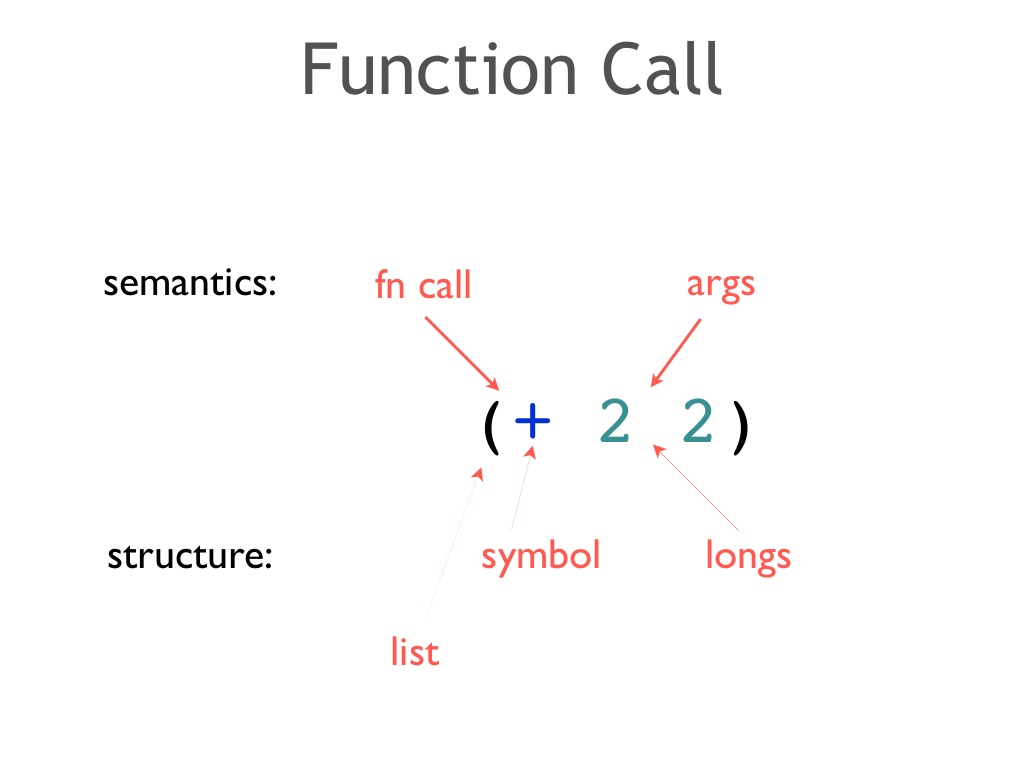
Yes. Really. Clojure programs are written using those just those primitives and that one simple rule language designers dont want you to know about.
Lets look at a function that makes other functions defn which you can
read as "define function".
(defn greet
"returns a friendly greeting"
[your-name]
(str "Hello, " your-name))
Go ahead and try it out:
(greet "Chris Broski, the one true Chris!!!")
Lets look at this in detail:
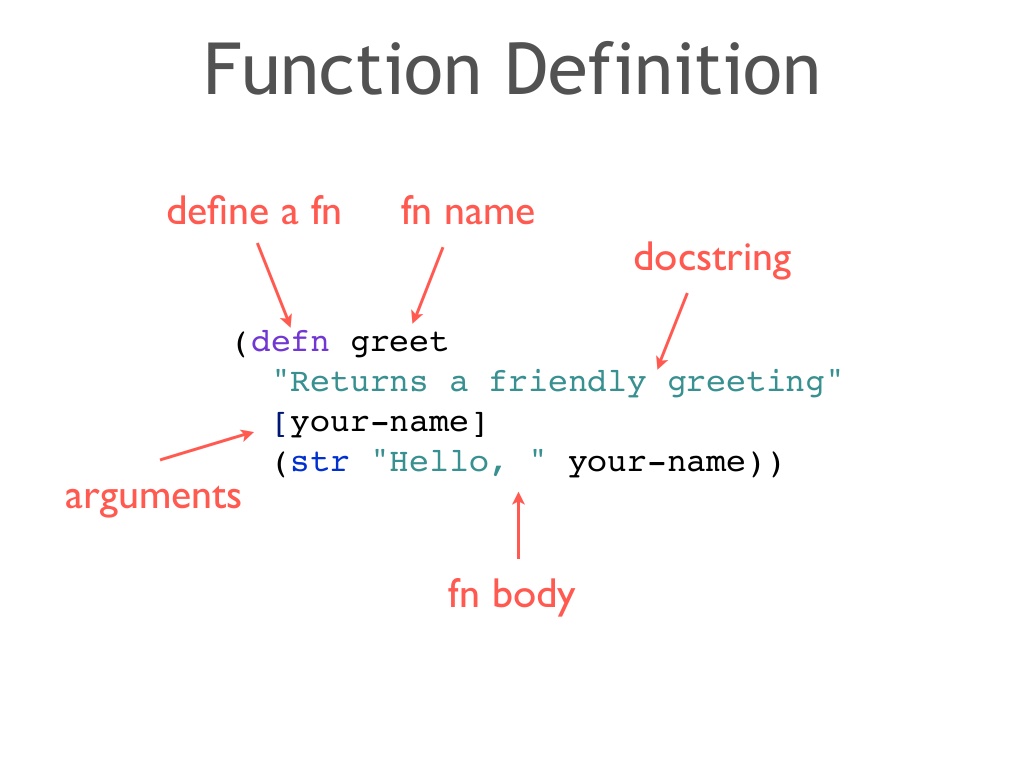
So you can see that we built this function using our core primitives:
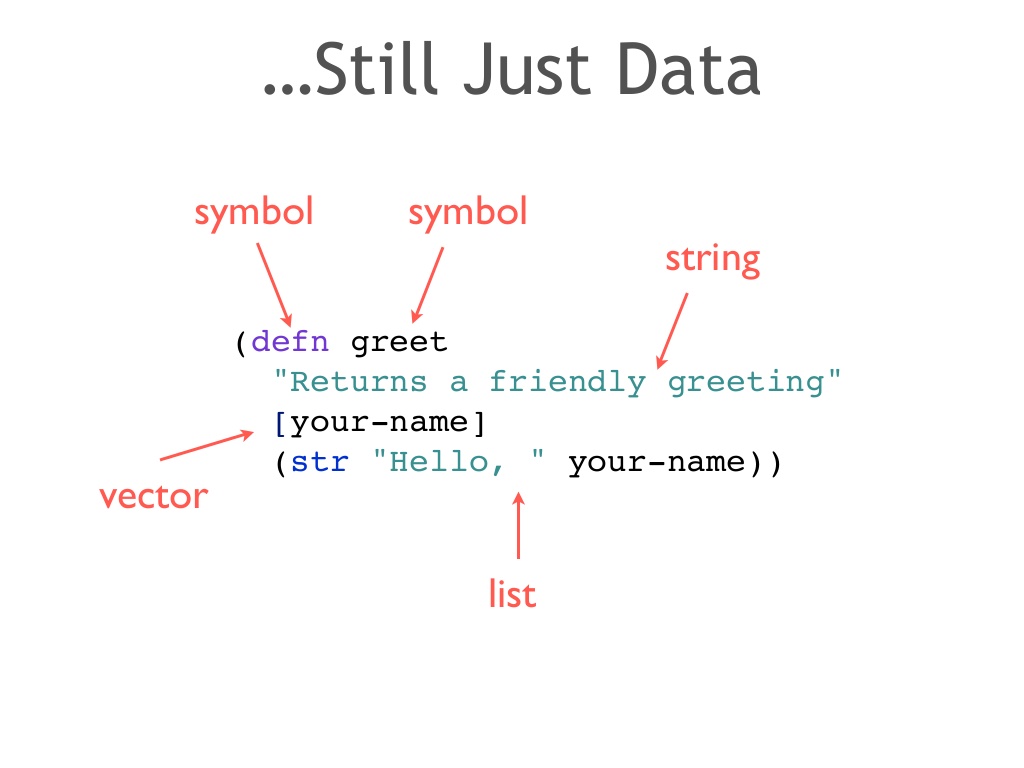
Macros allow you to extend the language. This means you can make a DSL quite easily.
;; ignore the namespace
(ns my.m$macros)
(defmacro backwards
[form]
(reverse form))
(my.m/backwards (" backwards" " am" "I" str))
This macro backwards intercepted the form (" backwards" " am" "I" str) and reversed it
to (str "I" "am " "backwards") before that form evaluated. This is important, because
as we discussed The operator must be the first thing in the form/list. See what happens without the macro?
(" backwards" " am" "I" str)
This is made possible because Clojure is a Lisp and so you as a programer can manipulate both the regular form (what any language can do) but also the form created the parser and lexer:
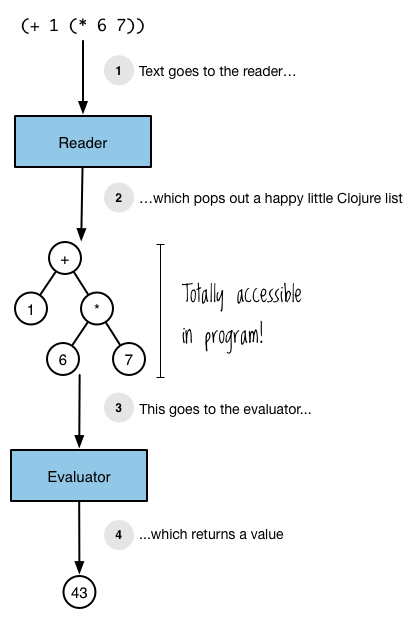
Generally speaking, you should strongly prefer functions over macros. However their are times when using a macro can greatly simplify a problem. Here is a blog post about when to use macros if you want to learn more. But the three main situations are:
Not much syntax
Not much about ordering
A preference for re-using the same data structures.
Macros allowing for powerful language manipulation.
A Protocol is :
a set of rules governing the exchange or transmission of data between two services.
Lets work through a quick example. Say we have three Reversible things.
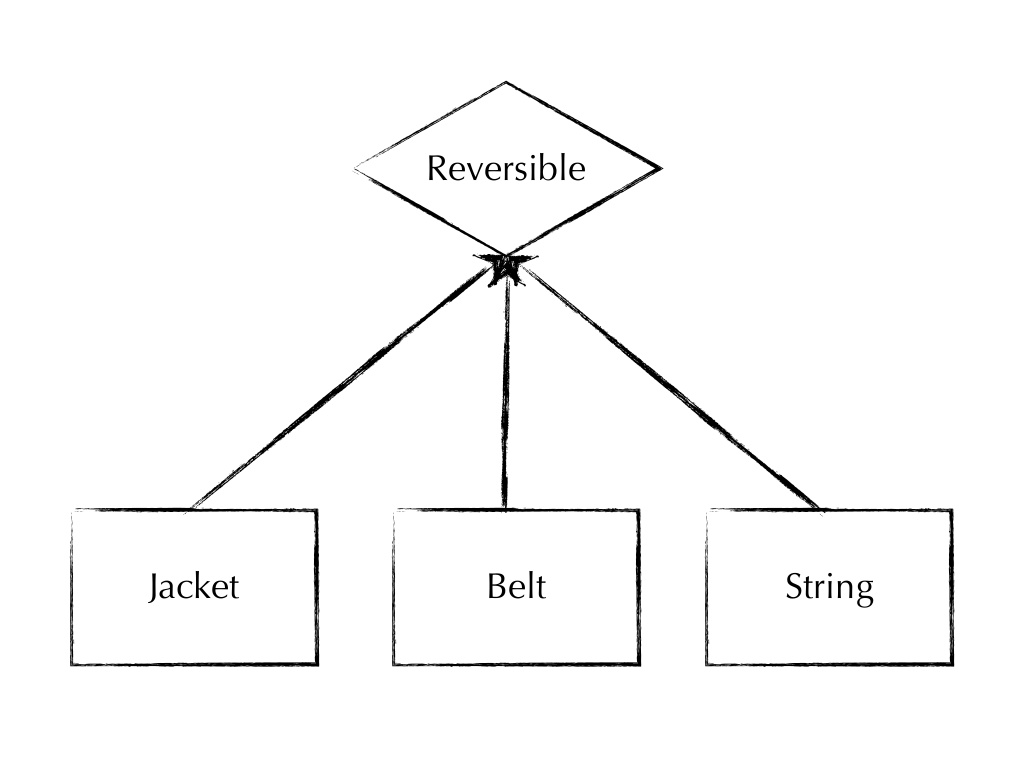
In this case our protocol is the Ability to reverse things and we need a way set of rules to govern how different services/types are reversed.
How would i go about modeling this in a OO language? Possible something like this:

The Interface abstraction in Java would Interface. The Implementation abstraction in Java would be a Class.
However it seems like something isn't labeled on our Model, the arrows to and from our interface:
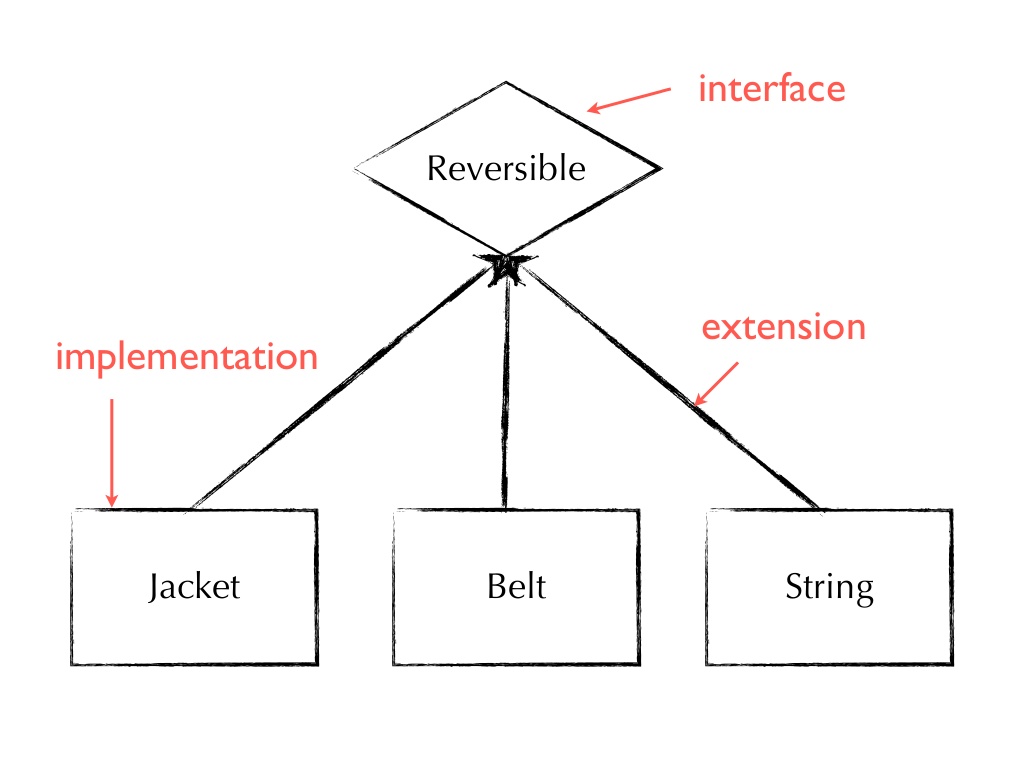
What is that in Java? Or Ruby? Or javascript? It's an interesting question, and will go into it more an just a bit.
In java this often times it involves some sort of design pattern. For instance, I believe the Adaptor pattern might help:
<img src="/img/ClassAdapter.png"
Class Adapter pattern
This adapter pattern uses multiple polymorphic interfaces implementing or inheriting both the interface that is expected and the interface that is pre-existing. It is typical for the expected interface to be created as a pure interface class, especially in languages such as Java (before jdk 1.8) that do not support multiple inheritance of classes.[1]
If were in a dynamic language like Ruby and Python we might be able to monkey patch, but the patchs might overlap and cause problems.
To make something Simpler, identify the part of the Model that has no specification and give it one. Put another way, if your Model has more things then names, its compounded to some degree.
In Clojure(script) we have an abstraction to extend a protocol, its simple ccalled extend-protocal.
(defrecord ReversibleTie [a b])
(extend-protocol IReversible
ReversibleTie
(^clj -rseq [tie] (->ReversibleTie (:b tie) (:a tie)))
js/String
(^clj -rseq [s] (str "We Welcome all your " s)))
Thats complaining probably because were extending an existing type with an existing method, which isn't a great idea...
So we make a tie, by instantiating a record, which at this stage you can think of like a ordered map with required keys:
(map->ReversibleTie {:a "a" :b "b"})
Now reverse it:
(reverse
(map->ReversibleTie {:a "a" :b "b"}))
And notice we can also "reverse" a String:
(reverse "WhiffleCakes")
What we just learned was Polymorhism in Clojure. How to have one function
reverse behave differently on different types. Unlike in most OO langauges we
have an additional abstraction extend which allows us to extend existing classes.
What we avoided by having this:
Lets say we want to model me at my highschool weight:

And the transition to my current weight...
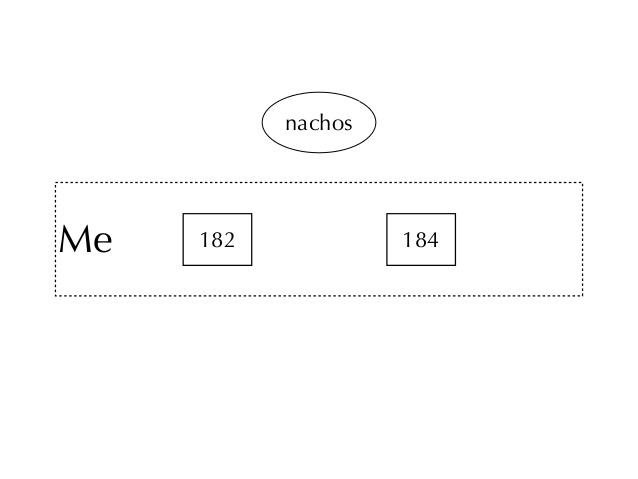
In OO languages we might do something like this.
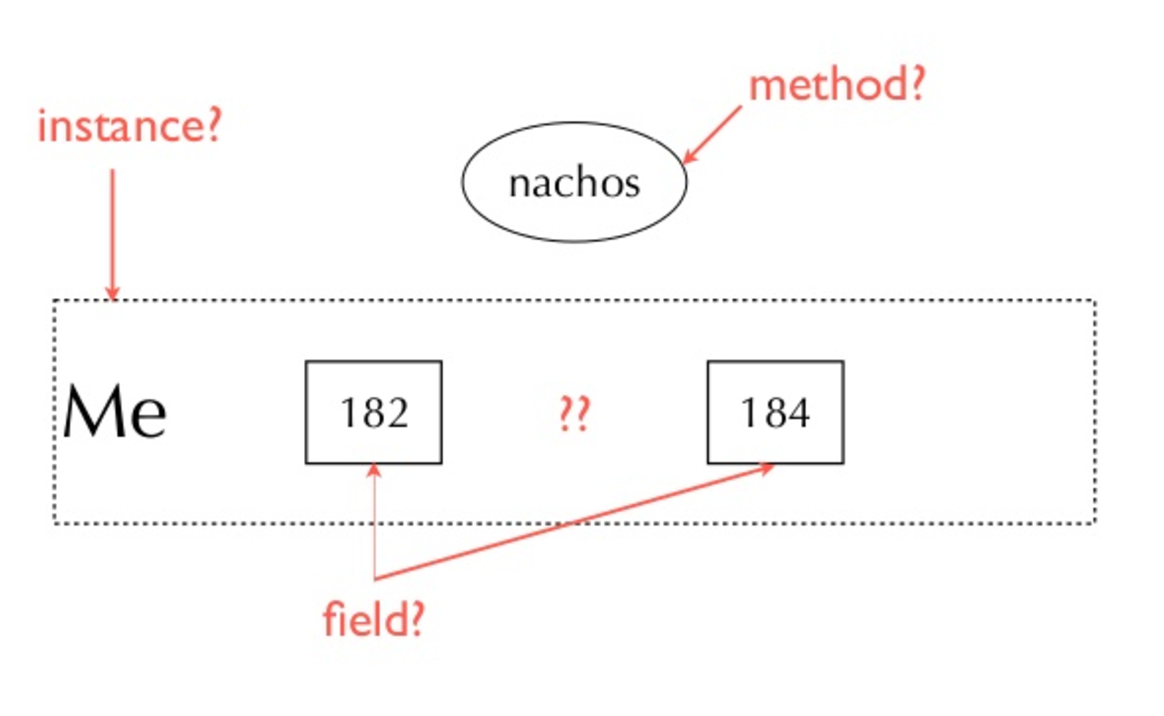
These question marks represent the idea that typically we only capture the most current value of something. So in terms of labeling things were forced to re-use an idea and leave others blank.
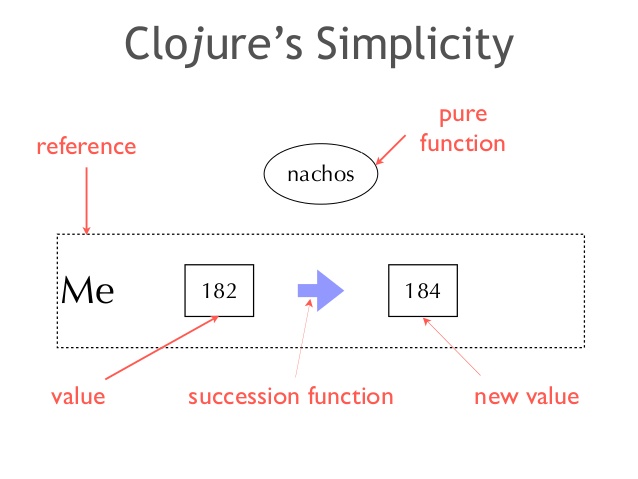
Clojure has a extremely rich set of built in tools to handle state management when its really necessary. Here were going to use whats called an atom.
(defprotocol Nachos
(yum [_] "eat some nachos"))
(defrecord Person [name lbs]
Nachos
(yum [person]
(update-in person [:lbs] + 2)))
(def me (atom (->Person "Drew" 182)))
(def me-before @me)
(swap! me yum)
(def me-after @me)
me-after
Were able to isolate the functional part of the program..
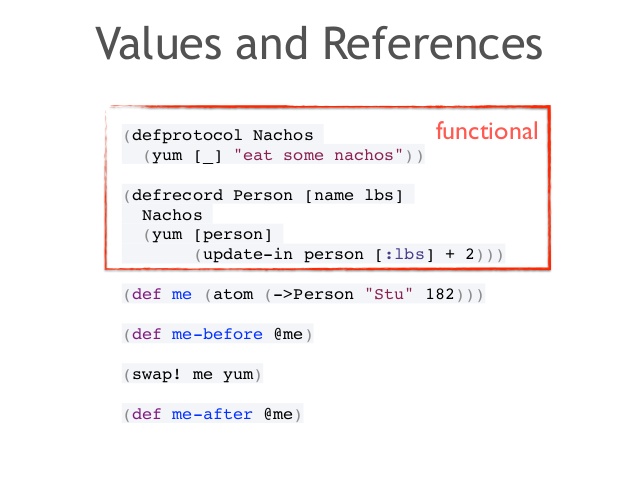
From the stateful part which requires update semantics
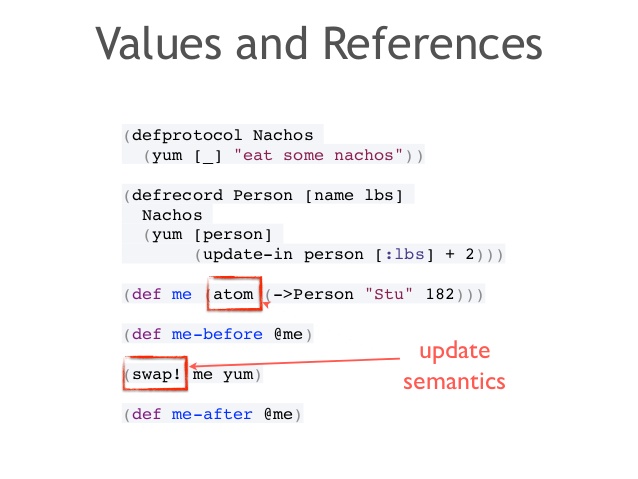
And effectively model the transition.
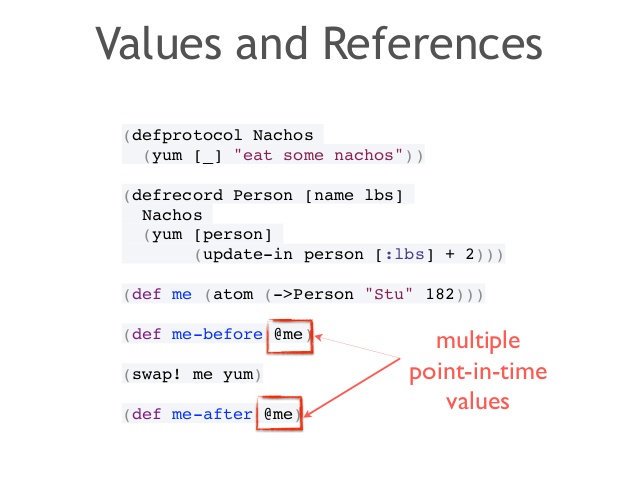
The key element here isn't that we captured before and after, we could do that easily with varibles in most languages. The key is that Atom is designed to work intelligently if their are multiple threads accessing that information.
When we call Swap on an atom, if that atom has been changed by the time were done applying the function to it, then we re-try with the new value:
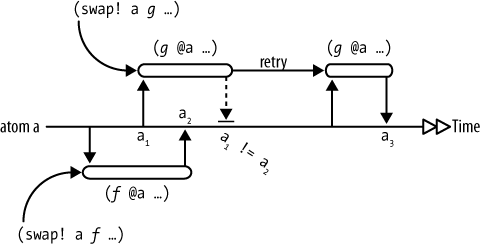
###Complexies avoided:
And its important to note that this problems can easily become combinatorial, that is, compound with each other.
So what jumps out at you when look at these various solutions to the dinning philosphers problems?
Clojure doesn't need any import statements! I'm not arguing this is better, but it's an important point that Concurrency was built into Clojure from the start.
So we have talked about how clojure enables simplify but its also useful to frame clojure in terms of what it enables you todo. Will look at some examples and see how they match to some high level themes:
To understand how Clojure enables concision lets look at a simple of
a function indexOfAny that find the index of the first character in
a string given a set of strings. Here is the specification:
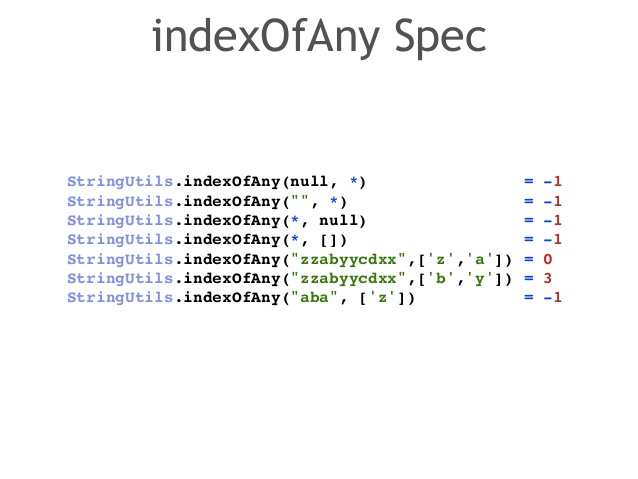
Were going to walk this code through a series of transformations in order to make it into a clojure program.
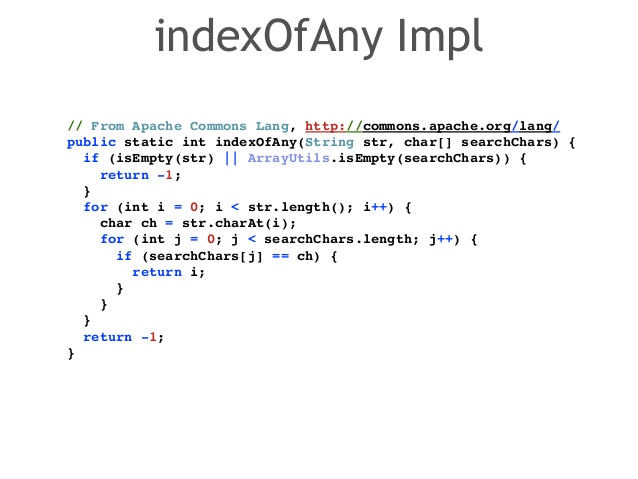
First we remove the corner cases, mainly returning -1 (which doesn't mean anything) and instead returning an empty list (which will show later):
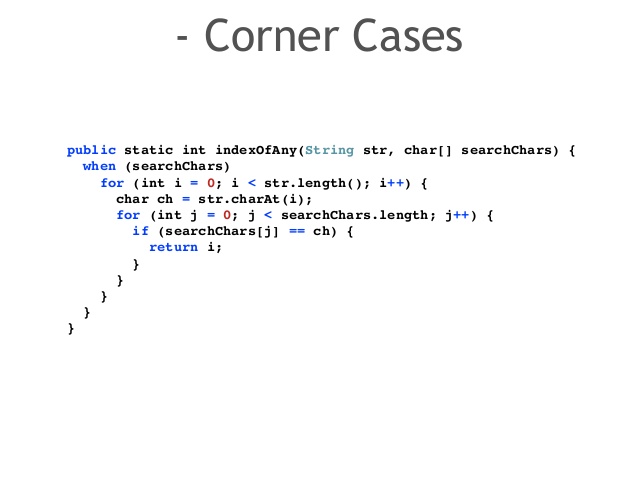
Then we remove the type declarations:
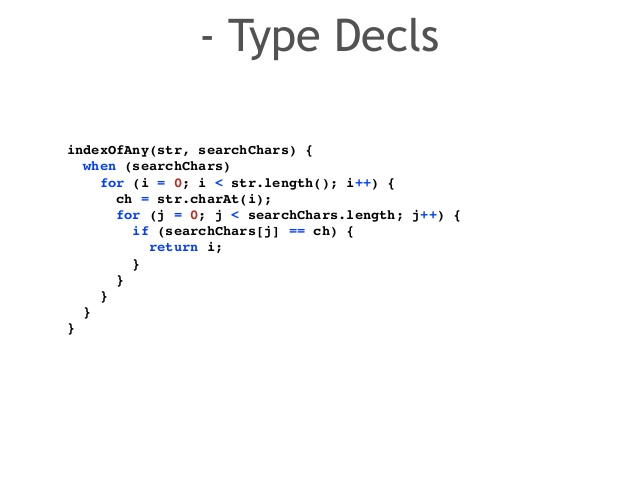
Leverage the when function:
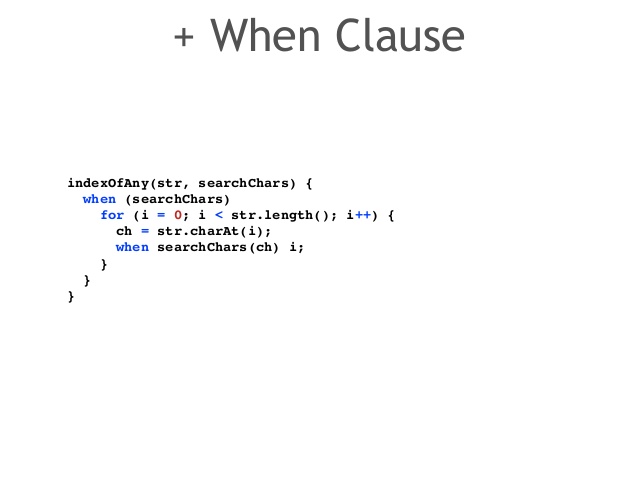
Leverage list comprehension:
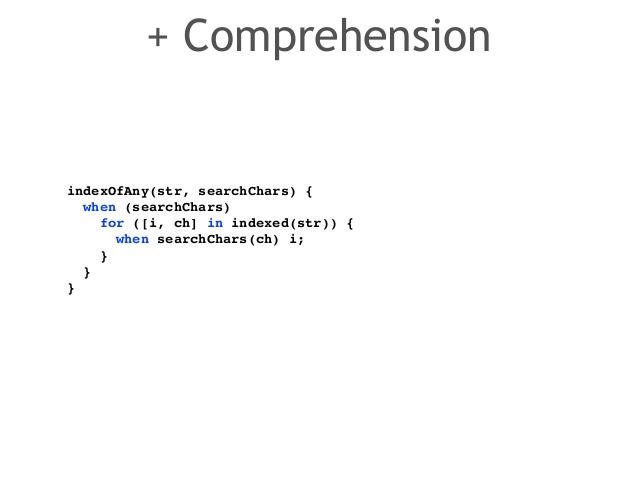
Use clojure syntax:
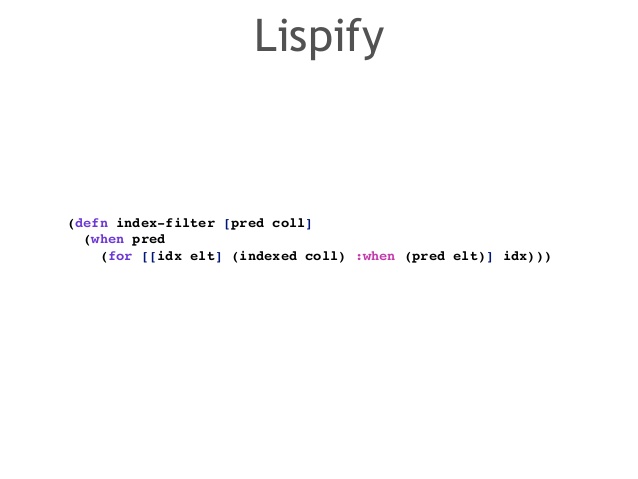
Looks like left ouf the implementation of indexed (unless im missing a built in function somewhere...)
(defn indexed [coll]
(map-indexed (fn [idx itm] [idx itm]) coll))
(defn index-filter [pred coll]
(for [[idx elt] (indexed coll) :when (pred elt)] idx))
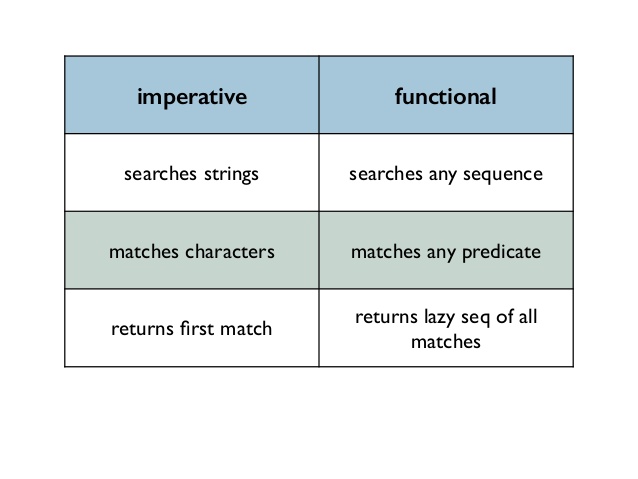
get indexs of heads in a stream of coin clips...
(index-filter #{:h}
[:t :h :t :h :t :h :h :t :t :t])
Or maybe the get the index of any fibonaccis number that is less then 10.
Make a quick fib generator:
(def fib-seq
((fn rfib [a b]
(lazy-seq (cons a (rfib b (+ a b)))))
0 1))
(take 20 fib-seq)
Find the index of those less then 10
(index-filter #(> % 10) (take 20 fib-seq))
So what was a 40 line program that only worked on strings is now a 4-5 line program that works on anything. This type of shortening nearly as well in another dynamic language like Python, Ruby, Javascript.
But i would argue Clojures has less language constructs then many of the other dynamic languages i have used and so tends to have better re-use of abstractions and functions which leads to smaller and more perform ant solutions overall. This is because clojure is made up of PICOs
While in many other languages you have a multiplication of types each with their own functions. In clojure, in stead of the developer defining new classes you just have:
Which means you can do things like model the HTML
(require '[reagent.core :as r])
(defn simple-component []
[:div
[:p "I am a component!"]
[:p.someclass
"I have " [:strong "bold"]
[:span {:style {:color "red"}} " and red "] "text."]])
(defn simple-parent [name]
[:div
[:b "my name is: " name]
[:p "I include simple-component."]
[simple-component]])
[simple-parent "drew"]
Lets filter something
(filter odd?)
Then take increment it..
(map inc)
Lets roll that into one a variable (def creates a global variable)
(def xf (comp (filter odd?) (map inc)))
What should be of interest to you at this point is that we haven't worried about the inputs and outputs. Whats amazing is that our code as written above will work on:
Here its is working on Collections:
(transduce xf + (range 5))
In order to build real services we need more then just a programming language, we need a persistent store. Of course Clojure can use any database (just like any language) but it has a lot of harmony with a particular database called Datomic. There is a lot we could say about it, but what i want to focus on is how you interact with it when programming.
Here is a datalog query (which is the query language of datomic):
[:find ?title
:where
[_ :movie/title ?title]]
# results...
"First Blood"
"Terminator 2: Judgment Day"
"The Terminator"
"Rambo III"
"Predator 2"
"Lethal Weapon"
"Lethal Weapon 2"
"Lethal Weapon 3"
"Alien"
"Aliens"
Dont' worry about how the query langauge works. Whats awesome is that this query is built using the same primitives as the rest of the language. Particularly its written in extensible data notation (edn) which is similar to Json, but it:
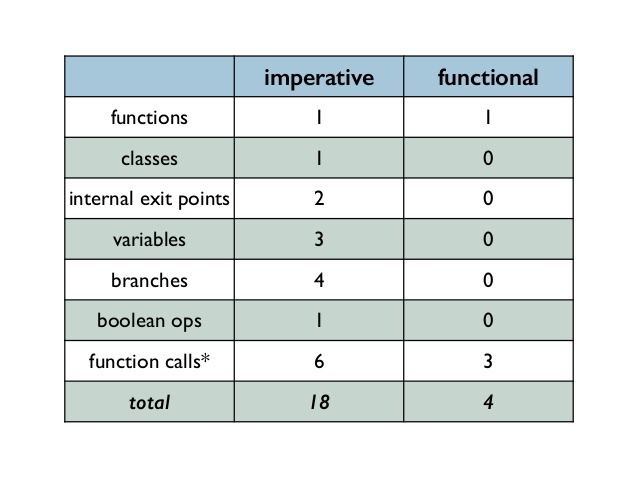
The result is that our programs are more robust and easier to understand and potentially faster because we let the language handle lower level details.
Lets say your work for a very important business whose API accepts Big Even Numbers from important discerning clients.
First some grunt work to pull in the required libraries:
(ns my.spec
(:require [clojure.spec.alpha :as s]
[clojure.spec.gen.alpha :as gen]))
Now we define our big even specification:
(s/def ::big-even (s/and integer? even? #(> % 1000)))
We confirm it works..
(s/valid? ::big-even 10)
(s/valid? ::big-even 100000)
Now we can attach this to our API and catch any nasty none big numbers that try to get in...
(s/explain-data ::big-even 5)
And just as important, we can use that specification to generator as many big even numbers as we want and use them as inputs.
(gen/sample ::big-even )
;;=> (3202 4502 3814 8902 20206)
clojurescript doesnt currently support generators
The arguments for agility in clojure is that we have already achieved it with this by satisfying the last three.
Clojure for the Brave and true also has install steps